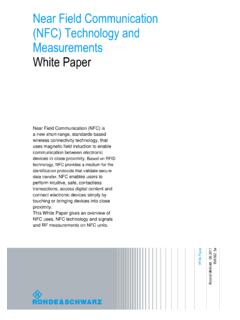Transcription of AWS Best Practices for DDoS Resiliency
1 AWS Best Practices for DDoS Resiliency First Published June 2015 Updated September 21, 2021 Notices Customers are responsible for making their own independent assessment of the information in this document. This document: (a) is for informational purposes only, (b) represents current AWS product offerings and Practices , which are subject to change without notice, and (c) does not create any commitments or assurances from AWS and its affiliates, suppliers or licensors. AWS products or services are provided as is without warranties, representations, or conditions of any kind, whether express or implied. The responsibilities and liabilities of AWS to its customers are controlled by AWS agreements, and this document is not part of, nor does it modify, any agreement between AWS and its customers. 2021 Amazon Web Services, Inc. or its affiliates. All rights reserved. Contents Introduction .. 1 Denial of Service Attacks .. 1 Infrastructure Layer Attacks.
2 3 Application Layer Attacks .. 5 Mitigation Techniques .. 7 Best Practices for DDoS Mitigation .. 11 Attack Surface Reduction .. 18 Obfuscating AWS Resources (BP1, BP4, BP5) .. 18 Operational Techniques .. 21 Visibility .. 21 Support .. 28 Conclusion .. 30 Contributors .. 30 Further Reading .. 30 Document revisions .. 31 Abstract It s important to protect your business from the impact of Distributed Denial of Service (DDoS) attacks, as well as other cyberattacks. Keeping customer trust in your service by maintaining the availability and responsiveness of your application is high priority. You also want to avoid unnecessary direct costs when your infrastructure must scale in response to an attack. Amazon Web Services (AWS) is committed to providing you with the tools, best Practices , and services to defend against bad actors on the internet. Using the right services from AWS helps ensure high availability, security, and Resiliency . In this whitepaper, AWS provides you with prescriptive DDoS guidance to improve the Resiliency of applications running on AWS.
3 This includes a DDoS-resilient reference architecture that can be used as a guide to help protect application availability. This whitepaper also describes different attack types, such as infrastructure layer attacks and application layer attacks. AWS explains which best Practices are most effective to manage each attack type. In addition, the services and features that fit into a DDoS mitigation strategy are outlined and how each one can be used to help protect your applications is explained. This paper is intended for IT decision makers and security engineers who are familiar with the basic concepts of networking, security, and AWS. Each section has links to AWS documentation that provides more detail on the best practice or capability. Amazon Web Services AWS Best Practices for DDoS Resiliency 1 Introduction Denial of Service Attacks A Denial of Service (DoS) attack is a deliberate attempt to make a website or application unavailable to users, such as by flooding it with network traffic.
4 Attackers use a variety of techniques that consume large amounts of network bandwidth or tie up other system resources, disrupting access for legitimate users. In its simplest form, a lone attacker uses a single source to carry out a DoS attack against a target, as shown in the following image. Diagram of a DoS Attack In a DDoS attack, an attacker uses multiple sources to orchestrate an attack against a target. These sources can include distributed groups of malware infected computers, routers, IoT devices, and other endpoints. The following diagram shows a network of compromised host participates in the attack, generating a flood of packets or requests Amazon Web Services AWS Best Practices for DDoS Resiliency 2 to overwhelm the target. Diagram of a DDoS Attack There are seven layers in the Open Systems interconnection (OSI) model and they are described in the Open Systems interconnection (OSI) Model table. DDoS attacks are most common at layers three, four, six, and seven.
5 Layer three and four attacks correspond to the Network and Transport layers of the OSI model. Within this paper, AWS refers to these collectively as infrastructure layer attacks. Layers six and seven attacks correspond to the Presentation and Application layers of the OSI model. AWS will address these together as application layer attacks. Examples of these attack types are discussed in the following sections. Open Systems interconnection (OSI) Model # Layer Unit Description Vector Examples 7 Application Data Network process to application HTTP floods, DNS query floods 6 Presentation Data Data representation and encryption TLS abuse Amazon Web Services AWS Best Practices for DDoS Resiliency 3 # Layer Unit Description Vector Examples 5 Session Data Interhost communication N/A 4 Transport Segments End-to-end connections and reliability SYN floods 3 Network Packets Path determination and logical addressing UDP reflection attacks 2 Data Link Frames Physical addressing N/A 1 Physical Bits Media, signal, and binary transmission N/A Infrastructure Layer Attacks The most common DDoS attacks, User Datagram Protocol (UDP) reflection attacks and synchronize (SYN) floods, are infrastructure layer attacks.
6 An attacker can use either of these methods to generate large volumes of traffic that can inundate the capacity of a network or tie up resources on systems such as servers, firewalls, intrusion prevention system (IPS), or load balancers. While these attacks can be easy to identify, to mitigate them effectively, you must have a network or systems that scale up capacity more rapidly than the inbound traffic flood. This extra capacity is necessary to either filter out or absorb the attack traffic freeing up the system and application to respond to legitimate customer traffic. UDP Reflection Attacks User Datagram Protocol (UDP) reflection attacks exploit the fact that UDP is a stateless protocol. Attackers can craft a valid UDP request packet listing the attack target s IP address as the UDP source IP address. The attacker has now falsified spoofed the UDP request packet s source IP. The UDP packet contains the spoofed source IP and is sent by the attacker to an intermediate server.
7 The server is tricked into sending its UDP response packets to the targeted victim IP rather than back to the attacker s IP address. The intermediate server is used because it generates a response that is several times larger than the request packet, effectively amplifying the amount of attack traffic sent to the target IP address. The amplification factor is the ratio of response size to request size and it varies depending on which protocol the attacker uses: DNS, NTP, SSDP, CLDAP, Amazon Web Services AWS Best Practices for DDoS Resiliency 4 Memcached, CharGen, or QOTD. For example, the amplification factor for DNS can be 28 to 54 times the original number of bytes. So, if an attacker sends a request payload of 64 bytes to a DNS server, they can generate over 3400 bytes of unwanted traffic to an attack target. UDP reflection attacks are accountable for larger volume of traffic in comparison to other attacks. The UDP Reflection Attack figure illustrates the reflection tactic and amplification effect.
8 UDP Reflection Attack SYN Flood Attacks When a user connects to a Transmission Control Protocol (TCP) service, such as a web server, their client sends a SYN synchronization packet. The server returns a SYN-ACK packet in acknowledgement, and finally the client responds with an acknowledgement (ACK) packet, which completes the expected three-way handshake. The following image illustrates this typical handshake. Amazon Web Services AWS Best Practices for DDoS Resiliency 5 SYN 3-way Handshake In a SYN flood attack, a malicious client sends a large number of SYN packets, but never sends the final ACK packets to complete the handshakes. The server is left waiting for a response to the half-open TCP connections and eventually runs out of capacity to accept new TCP connections. This can prevent new users from connecting to the server. The attack is trying to tie up available server connections so that resources are not available for legitimate connections.
9 While SYN floods can reach up to hundreds of Gbps, the purpose of the attack is not to increase SYN traffic volume. Application Layer Attacks An attacker may target the application itself by using a layer 7 or application layer attack. In these attacks, similar to SYN flood infrastructure attacks, the attacker attempts to overload specific functions of an application to make the application unavailable or unresponsive to legitimate users. Sometimes this can be achieved with very low request volumes that generate only a small volume of network traffic. This can make the attack difficult to detect and mitigate. Examples of application layer attacks include HTTP floods, cache-busting attacks, and WordPress XML-RPC floods. In an HTTP flood attack, an attacker sends HTTP requests that appear to be from a valid user of the web application. Some HTTP floods target a specific resource, while more complex HTTP floods attempt to emulate human interaction with the application.
10 Amazon Web Services AWS Best Practices for DDoS Resiliency 6 This can increase the difficulty of using common mitigation techniques like request rate limiting. Cache-busting attacks are a type of HTTP flood that use variations in the query string to circumvent content delivery network (CDN) caching. Instead of being able to return cached results, the CDN must contact the origin server for every page request, and these origin fetches cause additional strain on the application web server. With a WordPress XML-RPC flood attack, also known as a WordPress pingback flood, an attacker targets a website hosted on the WordPress content management software. The attacker misuses the XML-RPC API function to generate a flood of HTTP requests. The pingback feature allows a website hosted on WordPress (Site A) to notify a different WordPress site (Site B) through a link that Site A has created to Site B. Site B then attempts to fetch Site A to verify the existence of the link.
















